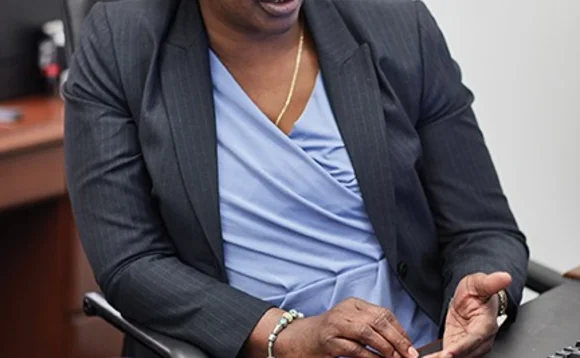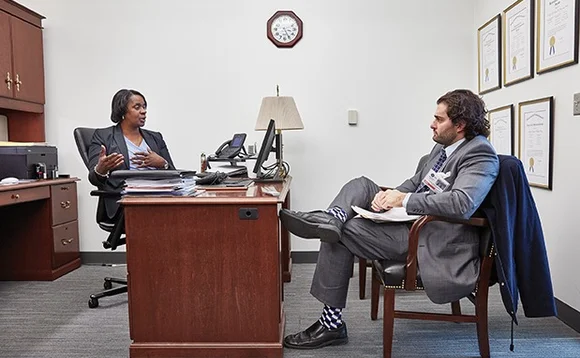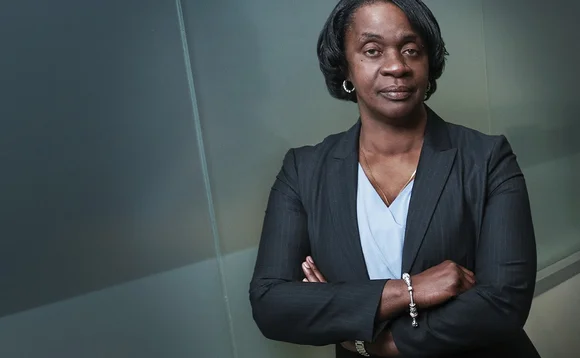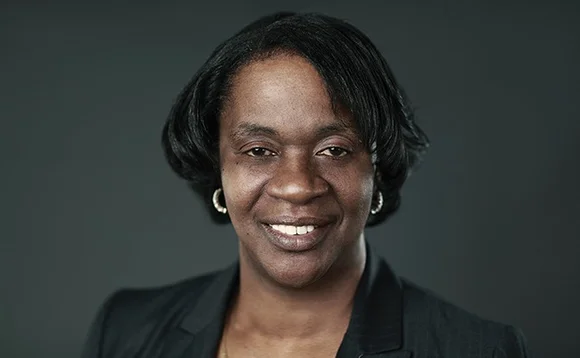Won't Back Down: SEC CIO Pamela Dyson
Dyson discusses the lessons learned after working nearly three decades in the federal government.





A can-do attitude has led Pamela Dyson to her role as CIO at the Securities and Exchange Commission. The head of technology of one of the biggest financial regulators in the US talks with Dan DeFrancesco about the challenges she faces in her job and her plans around leveraging big data. Photos by Jose Saenz
Pamela Dyson just wanted to learn about football.
It’s not that she was an amateur when it came to athletic endeavors. Basketball. Horseshoes. You name it, Dyson and her three older brothers played it growing up in Calvert County, a peninsula in southern Maryland bordering the Chesapeake Bay.
And while so many sports came easily to Dyson, football was different. The game was complicated with its stops, starts and convoluted rules. She had a tough time grasping it as a kid.
It’s the way government works. We’re all about compliance at the SEC. We’re a regulator, so we’ve got to eat our own dog food sometimes. - Pamela Dyson, SEC CIO
Her brothers weren’t much help. During Washington Redskins games—the team of choice for the boys—Dyson would pepper them with questions: What does that mean? What’s a foul? Tired of her incessant questioning, the boys would eventually force her out of the house.
“Go play outside,” they’d say.
This, more than anything else, motivated Dyson. It wasn’t just that she didn’t understand football; it was that her brothers did. She grew up playing with boys, leading people to label her a tomboy. That assessment, however, was incorrect, according to Dyson.
“I wasn’t a tomboy. I was better than the boys,” Dyson says. “I was never a tomboy. I didn’t want to be like them. They wanted to be like me.”
That’s just the kind of person Dyson is. Intensely shy but brimming with self-confidence, Dyson is not the type to back away from a challenge. It’s why years later, during her freshman year of high school, she went out for the cheerleading team despite having a healthy amount of stage fright. Not only did she make the team, she served as a team captain for three years, all while battling nerves up until the final home game.
So it’s easy to see how there was no way Dyson was going to accept not understanding something her brothers did. She made it her mission to view as much football as possible. Unable to watch the Redskins, Dyson settled for seeing other teams play, particularly on Monday Night Football.
One squad in particular stood out to Dyson. The Dallas Cowboys seemed to be playing every time Dyson turned on the TV. She was immediately impressed by legendary Cowboys coach Tom Landry, whose signature fedora and stoic look gave off the impression of an authoritative figure. The more football Dyson watched, the more she saw the Cowboys.
Soon, she learned the players’ names and started rooting for them, and as it so happened, their biggest divisional rival at the time was the Redskins, a point Dyson was more than happy to bring up with her siblings.
A devilish smile spreads across Dyson’s face as she recalls when she first started grasping the game.
“Once I had learned football and my favorite team was the Cowboys … boy, did I stick it to them,” she says.
Head On
One might be inclined to think that that type of attitude wouldn’t suit someone who has worked for the federal government for nearly three decades. But that would be wrong. Dyson, who has served as the CIO for the US Securities and Exchange Commission (SEC) since February 2015, tackles problems head on.
Many people associate the federal government with bureaucracy and a lack of a desire to innovate, but it was a reversal of roles that got Dyson to make the initial jump into the public sector. She had spent just under a year trying to get Interleaf, an electronic publishing system, up and running at Westinghouse Corp. before she decided her time would be better suited elsewhere.
“When I came in, I was a newbie, and the other thing was that I was very young,” Dyson recalls. “I actually had a lady say to me, ‘Look, I have children older than you. You don’t get to tell me what to do.’ That was the kind of resistance I was facing.”
It was the US International Trade Commission (ITC), a small agency of the federal government focused on US imports, which proved to be a sanctuary for Dyson of forward-thinking people. The ITC was interested in implementing Interleaf and wanted her to come aboard to help with the process. Dyson joined in 1987 as the branch chief for design. From there, she climbed the ladder, eventually reaching the position of deputy CIO in 2005.
Thanks to the small size of the agency, Dyson’s 23 years at the ITC gave her the opportunity to gain valuable experience about the intricacies of working for the federal government. Issues around human resources, unions, budgets and acquisition rules all came across Dyson’s desk.
“It gave me exposure to all of the federal regulations,” Dyson says. “Ironically, being at a small agency really is what propelled me to come into a job like this at the SEC. I had a broad view of the way government operates. A small agency allows you to wear multiple hats.”
Key Communicator
Dyson arrived at the SEC in 2010 as the assistant director for enterprise operations and wasted little time before entering the fray. Her first move was to talk to her fellow colleagues about what their biggest gripes were with the technology department. She was committed to better understanding her customers’ pain points, even if it meant having to reach out to every SEC employee individually.
Thomas Bayer, who joined the SEC around the same time as Dyson to serve as the regulator’s CIO, balked at the idea when Dyson first told him about it.
“He just looked at me and said, ‘Pam, they’re going to hand you your tush; you’re going to get killed out there,’” Dyson says. “My focus was on the operational perspective and improving service delivery and customer service, because there wasn’t a lot of that when we got here. The customers were very frustrated. IT was disconnected from the business. We were a utility—we weren’t a business partner.”
A self-described people’s person, Dyson had no problem getting involved early and interacting with her SEC colleagues. In fact, it was her strength as a communicator that played a significant role in her landing her job at the SEC.
Originally, Dyson had applied for the CIO role at the SEC in 2010. The agency was looking for someone with more experience at a larger firm, according to Jayne Seidman, deputy COO of the SEC, who was on the search committee and who interviewed Dyson. However, Seidman and Jeff Heslop, the SEC’s COO, both felt Dyson was a strong candidate for one of the other roles the agency was filling at the time.
Seidman says Dyson’s calm demeanor, direct answers to questions, and understanding of the intricacies of working for the federal government all stood out during the interview process. However, one of her biggest assets was her ability to listen. It’s a trait that’s easily discernable, even during a brief conversation with her.
“She’s as good a manager as I’ve seen in IT in my career, and I’ve been around forever,” Seidman says. “She really knows how to manage and listen to people, and our customers are very happy. If she sees a problem, she’ll go and talk to somebody. She’s not going to let it fester. She’s hands on in the way that helps the organization.”
Big Data, Big Task
Now, as the CIO, Dyson takes on one of the biggest challenges of her career: leveraging the massive amount of data the SEC currently holds. An Oracle Fusion Middleware platform has been implemented, and, according to Dyson, is at 60 to 70 percent capacity, and could potentially go beyond that threshold.
Although things are running smoothly now, Dyson admits that six months ago the future did not look as bright. At one point, she says, she considered whether or not she wanted to scrap the entire project.
The main problem was around developers writing code that could run on the platform. Many just didn’t know how to write code for Oracle Fusion Middleware, Dyson explains, and the agency got ahead of itself during development. A blueprint of what the SEC wanted the developers to build wasn’t established. Dyson compares it to moving into a development with cookie-cutter homes but not knowing whether you want a two- or three-car garage, or a security system.
To further complicate matters, Oracle is expensive and complicated, Dyson says. The SEC needed to get funding to bring in consultants to help with the project due to the agency’s lack of that particular skill set in-house.
The regulator also didn’t have the benefit of learning lessons from mistakes other agencies had made. According to Dyson, the SEC is at the forefront of innovation in this space, and there are not a lot of similar systems when it comes to regulating the financial services industry that the agency can use as an example. Eventually, however, a standard architecture and governance was established and the project continued, Dyson says.
“We had development teams writing code for Oracle based on the way they wanted to write code. They were using their own recipe,” Dyson says. “I think a part of that was the dearth of skill sets—we committed to something and we didn’t have those skill sets internally. It was a matter of getting the consultants in that would help us get that type of skill set.”
Challenging Build
These are the types of challenges Dyson faces that might not be commonplace for a CIO at a big bank or asset manager. If JPMorgan or Vanguard has a technology project they want to pursue, they more than likely either have the talent necessary to build it in-house or they can purchase it from a third-party. For Dyson, every project is marred in red tape as the SEC has to follow strict acquisition rules any time it needs to use a third party, which is often.
There is the possibility to avoid the request-for-proposal (RFP) stage by doing a sole source contract—where there is only one company that can provide a particular service—but those opportunities are few and far between, Dyson says.
There is also the issue of money. Budgets are harder to project in the public sector when they so heavily rely on necessary funding from the government. Also, it’s a federal requirement that all applications go through a security review before being released into a live production environment. And while the private sector does its fair share of putting platforms through cyber-security tests, data at a bank getting compromised doesn’t lead to its employees being subpoenaed, which is the case at the SEC.
Dyson admits it’s frustrating not being able to deliver solutions to her business partners as quickly as possible, but she believes that no other federal agency is as creative, while remaining compliant, about finishing projects.
“It’s the way government works. We’re all about compliance at the SEC,” Dyson says. “We’re a regulator, so we’ve got to eat our own dog food sometimes.”
Adding Analytics
Despite all those challenges, Dyson is still fully committed to her next project: building applications on top of the SEC’s enterprise data warehouse. Some of the solutions will be internal and focused on workflow. Applications like the SEC’s tips, complaints and referral (TCR) system will be on the platform as well as the national examination program, the primary system used to do examinations by the SEC’s enforcement division.
Investigation, exam, filing and Edgar data will all sit in a single system, Dyson says. The benefits, she says, will be that the agency will not only be able to collect more data, but it will be able to execute better data analysis. Examiners will also be able to do more data mining. Visualization of data will also be made available, helping to detect fraud.
What happens after that is still unclear. Dyson is adamant that she wants to end her career outside the federal government. However, first and foremost, she says she is committed to supporting SEC chairwoman Mary Jo White, who named her CIO.
She also says that she wants to see through the plans she has around helping the agency leverage big data, a project she estimates will take another 24 months. If Dyson’s timeline is correct, by the time the big data project is completed, she would have spent 30 years working in the federal government, which is another goal of hers. It’s ironic for Dyson, who says she never thought she’d end up in the government for this long.
“The funniest thing is, when I came into government, I was used to the pace of the private sector,” Dyson says, explaining that what she had initially anticipated on entering the public sector never really transpired. “It’s going to be too slow. I’ll be there for three years, and I’ll come back out,” she anticipated.
That was 28 years ago.
Pamela Dyson Fundamental Data
Name: Pamela Dyson
Title: CIO, US Securities and Exchange Commission
Hometown: Calvert County, Md.
Education: BS in applied design from University of Maryland in College Park
Hobbies: Reading, the arts, Maryland Terrapins football and basketball, the Dallas Cowboys
Only users who have a paid subscription or are part of a corporate subscription are able to print or copy content.
To access these options, along with all other subscription benefits, please contact info@waterstechnology.com or view our subscription options here: http://subscriptions.waterstechnology.com/subscribe
You are currently unable to print this content. Please contact info@waterstechnology.com to find out more.
You are currently unable to copy this content. Please contact info@waterstechnology.com to find out more.
Copyright Infopro Digital Limited. All rights reserved.
As outlined in our terms and conditions, https://www.infopro-digital.com/terms-and-conditions/subscriptions/ (point 2.4), printing is limited to a single copy.
If you would like to purchase additional rights please email info@waterstechnology.com
Copyright Infopro Digital Limited. All rights reserved.
You may share this content using our article tools. As outlined in our terms and conditions, https://www.infopro-digital.com/terms-and-conditions/subscriptions/ (clause 2.4), an Authorised User may only make one copy of the materials for their own personal use. You must also comply with the restrictions in clause 2.5.
If you would like to purchase additional rights please email info@waterstechnology.com
More on Regulation
Experts say HKEX’s plan for T+1 in 2025 is ‘sensible’
The exchange will continue providing core post-trade processing through CCASS but will engage with market participants on the service’s future as HKEX rolls out new OCP features.
No, no, no, and no: Overnight trading fails in SIP votes
The CTA and UTP operating committees voted yesterday on proposals from US exchanges to expand their trading hours and could not reach unanimous consensus.
Big xyt exploring bid to provide EU equities CT
So far, only one group, a consortium of the major European exchanges, has formally kept its hat in the ring to provide Europe’s consolidated tape for equities.
Jump Trading CIO: 24/7 trading ‘inevitable’
Execs from Jump, JP Morgan, Goldman Sachs, and the DTCC say round-the-clock trading—whether five or seven days a week—is the future, but tech and data hurdles still exist.
Pisces season: Platform providers feed UK plan for private stock market
Several companies in the US and the UK are considering participating in a UK program to build a private stock market composed of separate trading platforms.
How to navigate regional nuances that complicate T+1 in Europe
European and UK firms face unique challenges in moving to T+1 settlement, writes Broadridge’s Carl Bennett, and they will need to follow a series of steps to ensure successful adoption by 2027.
Nasdaq leads push to reform options regulatory fee
A proposed rule change would pare costs for traders, raise them for banks, and defund smaller venues.
The CAT declawed as Citadel’s case reaches end game
The SEC reduced the CAT’s capacity to collect information on investors, in a move that will have knock-on effects for its ongoing funding model case with Citadel.








